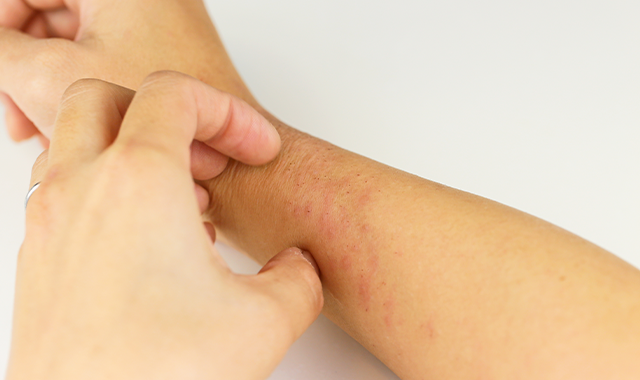- Case-Based Roundtable
- General Dermatology
- Eczema
- Chronic Hand Eczema
- Alopecia
- Aesthetics
- Vitiligo
- COVID-19
- Actinic Keratosis
- Precision Medicine and Biologics
- Rare Disease
- Wound Care
- Rosacea
- Psoriasis
- Psoriatic Arthritis
- Atopic Dermatitis
- Melasma
- NP and PA
- Skin Cancer
- Hidradenitis Suppurativa
- Drug Watch
- Pigmentary Disorders
- Acne
- Pediatric Dermatology
- Practice Management
- Prurigo Nodularis
- Buy-and-Bill
Article
When other treatments fail in atopic dermatitis, dupilumab succeeds
Author(s):
Dupilumab plus topical corticosteroids safe and effective after failure of cyclosporine in moderate-to-severe atopic dermatitis
The latest phase three data on dupilumab suggests that this recently approved biologic treatment is safe and effective in adults with moderate to severe atopic dermatitis (AD) who previously received cyclosporine A (CSA), or in whom CSA was contraindicated.
Combined with topical corticosteroids (TCS), the injectable IL-4- and IL-13-inhibiting monoclonal antibody improved measures of overall disease severity vs placebo in patients who were inadequately controlled on CSA, intolerant of CSA, or did not receive the immunosuppressive treatment due to medical concerns.
“This study showed dupilumab is effective with TCS when compared to placebo with TCS, and could be a very good alternative to CSA in this difficult-to-treat population,” said investigator Diamant Thaçi, M.D., director of the Comprehensive Center for Inflammation Medicine, University Luebeck, Germany.
“For these patients, there are very few treatment options,” added Dr. Thaçi, secondary author on the study, which was presented in a late-breaking session at the European Academy of Dermatology and Venerology (EADV) Congress in Geneva, Switzerland.
Cyclosporine A is approved for the treatment of atopic dermatitis in most European countries and Japan, Dr. Thaçi noted. While it is not approved in the U.S. for this particular use, the American Academy of Dermatology (AAD) July 2014 guidelines of care for management of atopic dermatitis state that CSA is “an effective off-label treatment option for patients with AD refractory to conventional topical treatment.” Most patients who receive the broad immunosuppressant will experience a significant decrease in disease activity within 2 to 6 weeks after treatment is started, according to the AAD guideline authors.
However, usage of CSA in European countries is mainly restricted for use as a short-term intervention rather than continuous long-term treatment, mainly due to limitations in safety profile, according to Dr. Thaçi. “CSA is effective in daily practice, but with many limitations,” he said in an interview with Dermatology Times. “Since AD is a chronic disease, long-term control of signs and symptoms is more important than temporary improvement at any time point.”
NEXT: New phase three data
NEW PHASE THREE DATA
In March 2017, the U.S. Food and Drug Administration (FDA) approved dupilumab injection, with or without topical corticosteroids, for the treatment of adults with moderate to severe eczema atopic dermatitis when topical therapies don’t provide adequate control or are inadvisable.
That approval was based in part on safety and efficacy data from three placebo-controlled clinical trials including a total of 2,119 adult participants with moderate to severe AD that was not adequately controlled by topical medication.
Similar to what was seen in those previous trials, the phase three study presented at EADV (known as CAFÉ) show that dupilumab with topical corticosteroids significantly improved overall measures of disease severity, including lesions, itch, quality of life measures and symptoms of anxiety and depression, with a safety profile consistent with what was previously observed for this agent.
The primary endpoint in the CAFÉ study was the proportion of patients achieving a 75% or greater improvement in Eczema Area and Severity Index (EASI-75) score at 16 weeks from baseline. Investigators reported that 59% of patients receiving dupilumab plus TCS achieved EASI-75, compared with 30% of patients receiving placebo plus TCS (P < 0.0001). Secondarily, they found that the mean percent change improvement in EASI was 78% and 80%, respectively, for patients receiving dupilumab weekly and every 2 weeks, respectively, compared with 47% in the placebo arm (P < 0.0001).
The proportion of patients reporting an adverse event was similar among dupilumab and placebo treatment arms, according to Dr. Thaçi. Conjunctivitis was more frequent in patients who received dupilumab with TCS, with 16% and 28% reported in the dupilumab weekly and every 2 weeks groups, versus 11% for the placebo arm.
“Dupilumab and cyclosporine A have not been evaluated in a head-to-head trial, so we cannot compare their safety profiles objectively,” Dr. Thaçi said. “However, with dupilumab we do not observe serious or severe infections, no liver or kidney nephrotoxicity, and no limitation of treatment due to comorbidities and concomitant medication. All of these are known side effects of CSA, which limits the use of CsA in a real world population.”
NEXT: In summary
IN SUMMARY
- Dupilumab combined with topical corticosteroids improved measures of overall disease severity vs placebo in patients who were inadequately controlled or intolerant of CSA, or did not receive the immunosuppressive treatment due to medical concerns.
- Conjunctivitis was more frequent in patients who received dupilumab with TCS, but overall, the proportion of patients reporting an adverse event was similar among dupilumab and placebo arms.
- Dupilumab plus TCS may be a good alternative to CSA in this difficult-to-treat population for whom there are few treatment options.
DISCLOSURES:
Dr. Thaçi reports he has been investigator, member of medical advisory board, and speaker for Regeneron/Sanofi.






